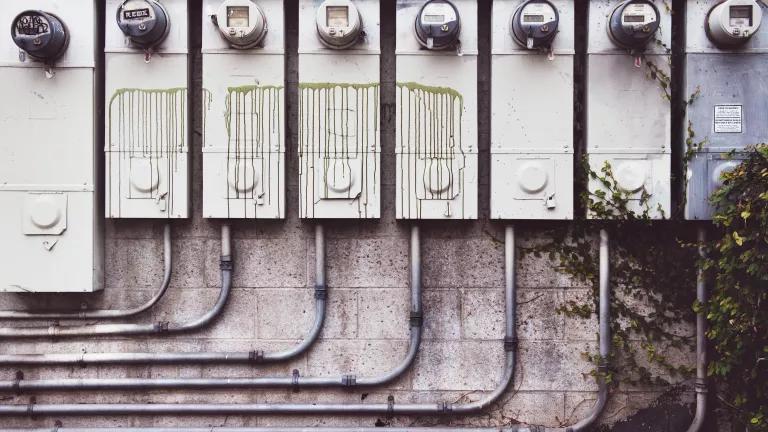A Plug for Plug Load:NY Needs Appliance Efficiency Standards

This blog was authored by Peter Ross, Energy Law and Policy Fellow, at the Frank J. Guarini Center on Environmental, Energy, and Land Use Law at the NYU School of Law
In January’s State of the State address, Governor Cuomo promised that by Earth Day, New York would have a new comprehensive energy efficiency framework, including a 2025 target for lowering the State’s overall energy consumption. As April 22 approaches, we’re eagerly awaiting the fulfillment of this promise, and of one measure in particular: setting minimum energy efficiency standards for appliances and equipment. Oft-overlooked and long overdue, efficiency standards will not only help New York reach its energy-savings targets, but also contribute to the state’s other climate goals: reducing greenhouse gas emissions (GHGs) to 40 percent below 1990 levels, and ensuring that 50 percent of our electricity comes from renewable sources, all by 2030.
For decades, efficiency standards in other jurisdictions have saved consumers money, reduced pollution, and increased grid reliability. Cumulatively and quietly, federal standards, which cover everything from microwaves to traffic lights, will cut Americans’ utility bills by $1 trillion, and save 71 quadrillion Btus of energy by 2020.
Although New York City’s building code requires high-efficiency plumbing fixtures (thereby reducing energy needed for hot water), much more needs to be done. Emissions associated with buildings still account for roughly 70 percent of the city’s carbon profile. Within this segment, plug load (i.e., the electricity used by appliances and equipment plugged into outlets) accounts for 20 percent of GHGs from commercial buildings, and 11 percent of citywide building emissions.The city is a national leader on local energy efficiency policy (having adopted the Greener Greater Buildings Plan in 2009 and a number of other leading initiatives to reduce energy consumption since then), but there is great opportunity for state appliance standards to further reduce building emissions.

New York has no statewide appliance and equipment standards currently in force, but 11 other states do. Federal standards established by the Energy Policy and Conservation Act (EPCA), as amended, and promulgated by the U.S. Department of Energy (DOE), cover many products, but states can fill in the gaps by prescribing standards for products not covered by federal law. In doing so, they often can create a de facto nationwide standard, as manufacturers are loath to create one appliance for, say, the California market and another for the rest of the country. When multiple states have the same standard, it increases this effect, and can establish momentum for the eventual adoption of a nationwide standard.
Last year, the Appliance Standards Awareness Project and the American Council for an Energy-Efficient Economy identified 21 products that were not covered by federal law and, if regulated, would result in significant energy and monetary savings. Together, their modeling indicates that these standards could reduce New Yorkers’ annual utility bills by $866 million in 2025 and $1.2 billion in 2035. The DOE recently issued a federal standard for one of the products—pool pumps—but for many of the remaining items, consumer savings would exceed compliance costs from day one and almost all would have a payback period of less than two years. New legislation would be needed since, unlike federal or California law, New York does not empower its regulators to identify new products and determine if a statewide standard would be appropriate.

To be truly visionary, New York should not only identify products that would benefit from efficiency standards now, but fundamentally reform the process through which future efficiency standards become law.
Following California and EPCA’s lead, the New York legislature should empower the New York State Energy Research and Development Authority (NYSERDA) or another appropriate state entity to proactively identify new products that would benefit from state minimum standards without having to pass additional legislation.
The law should include provisions to prevent undue delay, such as a private right of action or a default regulation that takes effect in the event no standard is timely promulgated. After all, New York passed the Appliance and Equipment Energy Efficiency Standards Act in 2005, and amended it in 2010, directing regulators to prescribe efficiency standards for 19 products by certain dates. No standards were ever implemented, and many of the identified products are either obsolete or preempted by federal law. Reforms should seek to simplify the policymaking process, ensure regulators have adequate staffing to fulfill their statutory obligations, and account for potential bottlenecks.
To determine whether a new standard is appropriate, New York could apply the same test used by DOE at the federal level, i.e. designing the standard “to achieve the maximum improvement in energy [or water] efficiency” that is “technologically feasible and economically justified.” As under EPCA, standards should be reviewed every six years.
For many products, there is no need to reinvent the wheel. Regulators should leverage other states’ expertise, particularly California, by considering evidence from their regulatory proceedings and reasonable conclusions derived therefrom. For instance, California recently prescribed a standard for computers and monitors that limits electricity consumption when the equipment is on, but not being used. New York could easily adopt this standard and magnify the market effect.

To streamline this process, New York could create a legal presumption of technological feasibility and economic justifiability that would attach to any minimum efficiency standard adopted by another state. The District of Columbia empowers its mayor to adopt efficiency standards for new products so long as they are “substantially identical” to ones already adopted by Maryland or Virginia. Proposed standards could be subject to a limited notice and comment to allow for stakeholder input, and to take into account local political, economic, and geographical conditions.
Such reforms for everyday appliances and equipment would represent the low-hanging fruit of climate-fighting policy. They would amplify the environmental force of other states’ laws and incentivize the private sector to invest in efficiency, all while lowering energy bills for customers. It is a simple, effective idea whose time has come.



